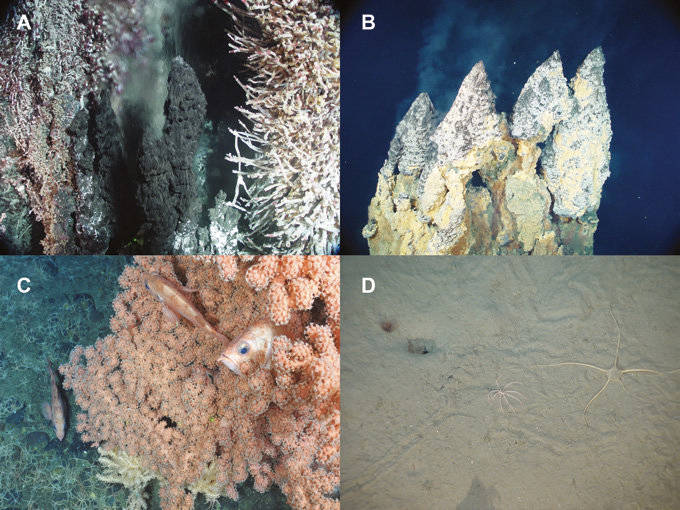When developing a marine protection area, Anna Metaxas believes that the genetics of species living within that area need to be taken into consideration. Tiny organisms can help make those decisions.
Metaxas, a professor at Dalhousie University in Canada with a doctorate in marine science, was Friday Harbor Labs’ 2019 Illg Distinguished Lecturer and presented her talk “Evidence-based conservation: designing well-connected Marine Protection Areas” at the San Juan Community Theatre on Aug. 7. She studies benthic invertebrate larvae ecology and has participated in the writing of approximately 200 scientific studies.
Most of Metaxas’ research is based on virtual larvae modeling. With this modeling, scientists can predict, based on currents, where the juvenile organisms will land.
“They’re teeny. … It’s really hard to find [larvae] to track them,” Metaxas said. “This is all virtual and it’s all modeling, because you can’t actually track larvae.”
Knowing from where larvae launch and land can help scientists decide whether a location is a source or a sink, and whether that area should be protected. A source is where organisms both originate and where they land, and a sink is where an organism travels to but does not produce emigrating animals.
When considering areas of marine environment protection, Metaxas said that managers tend to pick locations based primarily on landscape and partially on demographics. She added that scientists, however, believe that protection zones should be chosen based on the genetics of the organisms within them and less on demographics.
So, why are marine protected areas needed anyway? A study by James E. M. Watson and his colleagues published in 2018 indicated 87 percent of the ocean has been modified by human activity.
“Most of our ocean is heavily impacted by [human] activities. Most of those activities are climate change, invasive species, habitat loss … shipping and pollution,” Metaxas said. “There are places we’re really impacting in a big way and we continue to do a really bad job at mitigating some of those impacts.”
The majority of wilderness, both terrestrial and marine, that remains is in just 10 countries, which include Canada and the United States.
“To me, that means that we have a responsibility in these countries … to try to do our best to … sustain some of this wilderness for a little bit longer for the rest of the planet,” Metaxas said.
The United Nations created an agreement in 1992 titled the Convention of Biological Diversity that was signed by more than 190 nations; the United States signed the treaty but their signature was never ratified. The goal of the convention is to conserve biodiversity, sustainably use biodiversity and to share fair and equitably the benefits arising from the use of genetic resources.
In 2010, the convention parties devised a strategic plan for biodiversity with 20 targets. One section, Aichi Target 11, contained the goal of having 10 percent of coastal and marine waters protected by 2020. Metaxas said the countries will likely not be achieving that goal.
While the UN claims that 7.44 percent of global coastal and marine areas are protected, the Marine Conservation Institute says it’s really only 4.8 percent, according to Metaxas, and that’s the source she believes to be most accurate.
A marine protected area, as defined by the International Union for Conservation of Nature, “is a clearly defined geographical space, recognized, dedicated and managed, through legal or other effective means, to achieve the long term conservation of nature with associated ecosystem services and cultural values.” Criteria that can be used to identify areas that should be within marine protected areas include biogeography; ecology; naturalness; economic importance; social importance; scientific importance; international or national significance; practicality or feasibility; and duality or replication.
“Marine protected areas are just one tool; they’re not going to solve all of our problems,” Metaxas said.
At the deepest depths of the ocean, on a relatively unexplored seafloor, lie hydrothermal vents, teeming with life and ore that humans wish to mine.
“Deep-sea mining completely destroys the habitat and the animals,” Metaxas said. “We still don’t know where all the hydrothermal vents are.”
According to Metaxas, every time a deep-sea mining exhibition returns from the darkness, it brings up new animals that scientists have never encountered. In an ideal situation, spans of 100 kilometers every 100 kilometers along these hydrothermal vents would be a marine preservation area so that the animals residing along the hydrothermal vents don’t face extinction. The distance is based on how far geologists believe vents are located, Metaxas explained.
“You’re not going to convince the contractors,” Metaxas said, adding that the 150 member states of the Convention on Biological Diversity must be the ones to make this protection happen.
“It’s those difficult decisions that we have to make as a society in terms of where to prioritize where we put those conservation areas,” Metaxas said.



